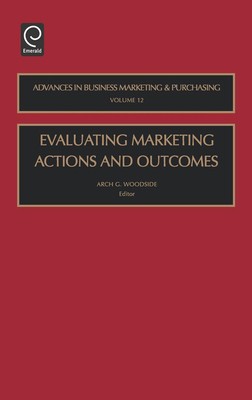
- We will send in 10–14 business days.
- Publisher: Jai Press Inc.
- ISBN-10: 0762310464
- ISBN-13: 9780762310463
- Format: 17.8 x 21.8 x 5.6 cm, hardcover
- Language: English
- SAVE -10% with code: EXTRA
Evaluating Marketing Actions and Outcomes (e-book) (used book) | bookbook.eu
Reviews
Description
What's really happening? For an organization this question contains at least four sub issues: What actions are being done now help to increase the organization's performance? What actions are wasted motions - what are we doing that does not contribute and wastes our time? What actions harm the organization's performance - what actions are counterproductive in helping the organization achieve what really needs to be accomplished? What actions are we not doing now but really should be doing to increase the organization's performance? A fifth, related, sub issue is how to go about finding out what is really happening-what research methods should executives use, as well as avoid using, to go about finding this out. Executive thinking differs fundamentally from scientific thinking in fundamental ways. Scientists and academic researchers are able to choose the problem, whereas in organizations, the problems (and symptoms of problems) are often thrust upon the executive. Scientists focus on a limited number of problems at a time, whereas executives are confronted with a vast number of potential problems and a myriad of possible presentation problem frames. Scientists have the relative luxury of time to explore the problem at hand, whereas executives, particularly CEOs, do not. The intention is for this volume to be read by executives wanting to learn how to reduce overconfidence, and to become more mindful, in making decisions and in learning how to scientifically evaluate the quality of outcomes that follow from implementing decisions.
EXTRA 10 % discount with code: EXTRA
The promotion ends in 18d.22:05:45
The discount code is valid when purchasing from 10 €. Discounts do not stack.
- Publisher: Jai Press Inc.
- ISBN-10: 0762310464
- ISBN-13: 9780762310463
- Format: 17.8 x 21.8 x 5.6 cm, hardcover
- Language: English English
What's really happening? For an organization this question contains at least four sub issues: What actions are being done now help to increase the organization's performance? What actions are wasted motions - what are we doing that does not contribute and wastes our time? What actions harm the organization's performance - what actions are counterproductive in helping the organization achieve what really needs to be accomplished? What actions are we not doing now but really should be doing to increase the organization's performance? A fifth, related, sub issue is how to go about finding out what is really happening-what research methods should executives use, as well as avoid using, to go about finding this out. Executive thinking differs fundamentally from scientific thinking in fundamental ways. Scientists and academic researchers are able to choose the problem, whereas in organizations, the problems (and symptoms of problems) are often thrust upon the executive. Scientists focus on a limited number of problems at a time, whereas executives are confronted with a vast number of potential problems and a myriad of possible presentation problem frames. Scientists have the relative luxury of time to explore the problem at hand, whereas executives, particularly CEOs, do not. The intention is for this volume to be read by executives wanting to learn how to reduce overconfidence, and to become more mindful, in making decisions and in learning how to scientifically evaluate the quality of outcomes that follow from implementing decisions.


Reviews